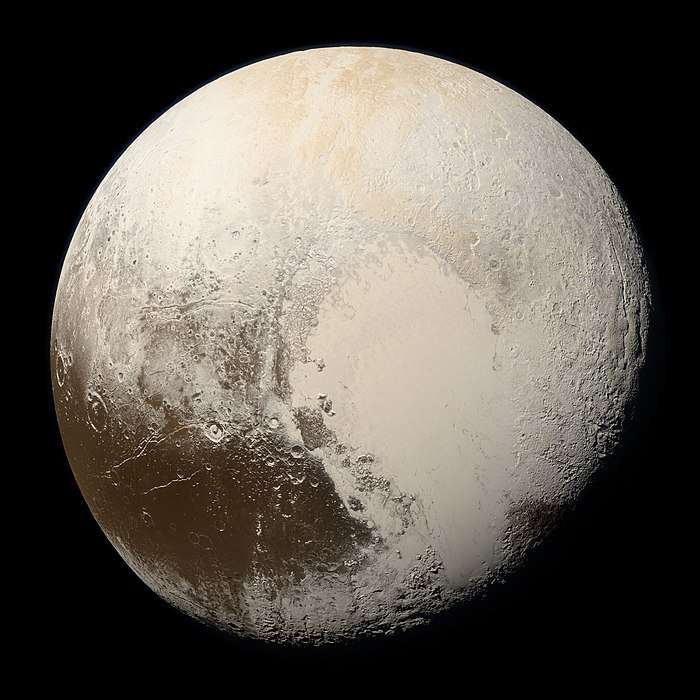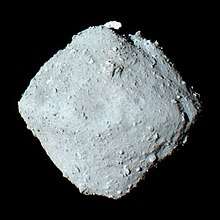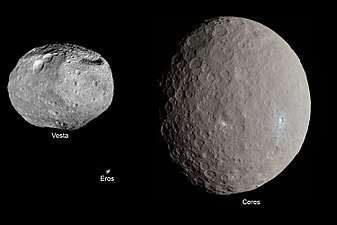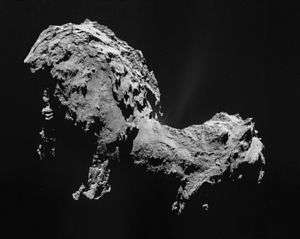List of minor planets and comets visited by spacecraft
The following tables list all minor planets and comets that have been visited by robotic spacecraft.


List of minor planets visited by spacecraft
Since the 1990s, a total of 16 minor planets – various asteroids, dwarf planets, and Kuiper belt objects – have been visited by space probes. Note that moons (not directly orbiting the Sun), comets and planets are not minor planets and thus are not included in the table below.
In addition to the listed objects, three asteroids have been imaged by spacecraft at distances too large to resolve features (over 100,000 km), and are hence not considered "visited". Asteroid 132524 APL was imaged by New Horizons in 2006 at a distance of 101,867 km, 2685 Masursky by Cassini in 2000 at a distance of 1,600,000 km, and 307 Nike by Pioneer 10 in 1972 at a distance of 8,800,000 km. The Hubble Space Telescope, a spacecraft in Earth orbit, has imaged several large asteroids, including 2 Pallas and 3 Juno.
| Minor planet | Space probe | |||||||
|---|---|---|---|---|---|---|---|---|
| Name | Image | Dimensions (km) (a) |
Discovery year |
Name | Closest approach | Remarks | ||
| year | in km | in radii (b) | ||||||
| 1 Ceres | 952 | 1801 | Dawn | 2015–2018 | 35 | 0.07 | first "close up" picture of Ceres taken in December 2014; probe entered orbit in March 2015; first dwarf planet visited by a spacecraft, largest asteroid visited by a spacecraft | |
| 4 Vesta | 529 | 1807 | Dawn | 2011–2012 | 200 approx. |
0.76 | space probe broke orbit on 5 September 2012 and headed to Ceres; first "big four" asteroid visited by a spacecraft, largest asteroid visited by a spacecraft at the time | |
| 21 Lutetia | 120×100×75 (100 km) |
1852 | Rosetta | 2010 | 3,162 | 64.9 | flyby on 10 July 2010; largest asteroid visited by a spacecraft at the time | |
| 243 Ida | 56×24×21 (28 km) |
1884 | Galileo | 1993 | 2,390 | 152 | flyby; discovered Dactyl; first asteroid with a moon visited by a spacecraft, largest asteroid visited by spacecraft at the time | |
| 253 Mathilde | 66×48×46 (58 km) |
1885 | NEAR Shoemaker | 1997 | 1,212 | 49.5 | flyby; largest asteroid visited by a spacecraft at the time | |
| 433 Eros | 34×11×11 (17 km) |
1898 | NEAR Shoemaker | 1998–2001 | landed | landed | 1998 flyby; 2000 orbited (first asteroid studied from orbit); 2001 landing; first asteroid landing, first asteroid orbited by a spacecraft, first near-Earth asteroid (NEA) visited by a spacecraft | |
| 951 Gaspra | 18.2×10.5×8.9 (12.2 km) |
1916 | Galileo | 1991 | 1,600 | 262 | flyby; first asteroid visited by a spacecraft | |
| 2867 Šteins | .png) |
4.6 | 1969 | Rosetta | 2008 | 800 | 302 | flyby; first asteroid visited by the ESA |
| 4179 Toutatis | 2.45 | 1934 | Chang'e 2 | 2012 | 3.2 | 0.70 | flyby;[1] closest asteroid flyby, first asteroid visited by a Chinese probe | |
| 5535 Annefrank | 4.0 | 1942 | Stardust | 2002 | 3,079 | 1230 | flyby | |
| 9969 Braille | 2.2×0.6 (1.6 km) |
1992 | Deep Space 1 | 1999 | 26 | 12.7 | flyby; followed by flyby of Comet Borrelly; failed to image it during closest approach, only taking images 14,000 km from the asteroid. | |
| 25143 Itokawa | 0.5×0.3×0.2 (350 meters) |
1998 | Hayabusa | 2005 | landed | landed | landed; returned dust samples to Earth in 2010 - first sample return mission from asteroid; smallest asteroid visited by a spacecraft, first asteroid visited by a non-NASA spacecraft | |
| 101955 Bennu | 0.490 | 1999 | OSIRIS-REx | 2019–present | 0.065[2] | 0.27 | arrived on 3 December 2018; entered lowest orbit on 12 June 2019; smallest object to be orbited by spacecraft and closest ever orbit;[3][4] touchdown planned to collect sample | |
| 134340 Pluto |  |
2,376 | 1930 | New Horizons | 2015 | 12,500 | 10.5 | flyby; first trans-Neptunian object visited, most distant object visited by a spacecraft (at the time of the visit) |
| 162173 Ryugu |  |
0.865 | 1999 | Hayabusa2 | 2019 | landed | landed | Rendezvoused with asteroid from June 2018 to November 2019. Successful touchdowns to collect a sample in February and July 2019.[5] Three landers and an explosive impactor successfully deployed to the surface.[6] |
| 486958 Arrokoth | 36×18×10 | 2014 | New Horizons | 2019 | 3.500 | 350 | Flew by Arrokoth (nicknamed Ultima Thule) on 1 January 2019, currently farthest object to be visited by a spacecraft. | |
Notes:
| ||||||||
List of comets visited by spacecraft
| Comet | Space probe | |||||||
|---|---|---|---|---|---|---|---|---|
| Name | Image | Dimensions (km) (a) |
Discovery year |
Name | Closest approach | Remarks | ||
| year | in km | in radii (b) | ||||||
| Giacobini–Zinner | 2 | 1900 | ICE | 1985 | 7,800 | 7,800 | first flyby of comet | |
| Halley | 15×9 | Known since 1759 (Precovered to 240 B.C. ) |
Vega 1 | 1986 | 8,889 | 1,620 | flyby | |
| Vega 2 | 1986 | 8,030 | 1,460 | flyby | ||||
| Suisei | 1986 | 151,000 | 27,450 | distant flyby | ||||
| Sakigake | 1986 | 6,990,000 | 1,270,747 | distant flyby | ||||
| Giotto | 1986 | 596 | 108 | flyby; first direct images of a comet nucleus | ||||
| ICE | 1986 | 31,000,000 | 5,647,000 | distant flyby | ||||
| Grigg–Skjellerup | 2.6 | 1902 | Giotto | 1992 | 200 | 154 | flyby | |
| Borrelly |  |
8×4×4 | 1904 | Deep Space 1 | 2001 | 2,171 | 814 | flyby; closest approach in September 2001 when probe entered the comet's coma[7] |
| Wild 2 |  |
5.5×4.0×3.3 | 1978 | Stardust | 2004 | 240 | 113 | flyby; first sample return mission from comet to Earth (2006) |
| Tempel 1 |  |
7.6×4.9 | 1867 | Deep Impact | 2005 | 500 | 80 | flyby; delivered an impactor |
| Deep Impact's impactor vehicle | 2005 | 0 | 0 | first landing on a comet (blasted a crater) | ||||
| Stardust | 2011 | 181 | 57.9 | flyby; imaged the crater created by Deep Impact | ||||
| C/2006 P1 (McNaught) | 2006 | Ulysses | 2007 | 260,000,000 | made an unexpected pass through the tail of the comet | |||
| Hartley 2 | 1.4 | 1986 | EPOXI (was Deep Impact) |
2010 | 700 | 1,000 | flyby; smallest comet visited | |
| Churyumov–Gerasimenko | 4.1×3.3×1.8 | 1969 | Rosetta | 2016 | 0 | 0 | first orbiter of comet (November 2014); impacted surface as of 2016; OSIRIS captured image with 11 cm/px-resolution in Spring 2015[8] | |
| Philae (Rosetta's lander) |
2014 | 0 | 0 | first soft landing on a comet (November 2014) | ||||
Notes:
| ||||||||
Spacecraft visited by comets
Comet C/2013 A1 passed close by planet Mars in October 2014, closer than the Moon is to Earth.[9] As of early 2014 it was calculated to pass as close as 0.00087 AU (130,000 km; 81,000 mi).[9] This was so close that the event was deemed dangerous to spacecraft in orbit around Mars.[10] Spacecraft that were active at that time included 2001 Mars Odyssey, Mars Express, MAVEN, Mars Orbiter Mission, and Mars Reconnaissance Orbiter in Mars orbit – and two on the surface – Mars Exploration Rover Opportunity and the Mars Science Laboratory Curiosity.
Planned visits
List of minor planets targeted for spacecraft visitation
NASA's Lucy spacecraft is scheduled to tour several Jupiter trojans and one main-belt asteroid between 2025 and 2033.[11]
The following table lists minor planets that are planned to be visited by spacecraft.
| Name | Diameter(a) (km) | Year of discovery | Spacecraft | Agency | Year of visit | Notes |
|---|---|---|---|---|---|---|
| 16 Psyche | 186 | 1852 | Psyche | NASA | 2026 | Future planned orbiting.[12] |
| 617 Patroclus | 141 | 1906 | Lucy | NASA | 2033 | Jupiter trojan, Trojan camp, binary system with satellite, 5th-largest Jupiter trojan[11] |
| 3200 Phaethon | 5 | 1983 | DESTINY+ | JAXA | 2026 | Rock comet and parent body of Geminids meteor shower[13] |
| 3548 Eurybates | 72 | 1973 | Lucy | NASA | 2027 | Jupiter trojan, Greek camp[11] |
| 11351 Leucus | 42 | 1997 | 2028 | Jupiter trojan, Greek camp, a slow rotator[11] | ||
| 15094 Polymele | 21 | 1999 | 2027 | Jupiter trojan, Greek camp[11] | ||
| 21900 Orus | 53 | 1999 | 2028 | Jupiter trojan, Greek camp[11] | ||
| 52246 Donaldjohanson | 4 | 1981 | 2025 | main belt asteroid[14] | ||
| 65803 Didymos | 1 | 1996 | DART / LICIA | NASA/ASI | 2022 | Kinetic impact to test asteroid deflection[15][16] |
| (153591) 2001 SN263 | Triple system: 2.8 km 1.1 km 0.4 km | 2001 | ASTER | AEB | 2022[17] | Triple system of the Amor group |
| 1991 VG | 5–12 m (16–39 ft) | 1991 | NEA Scout | NASA | 2022 | 2-year cruise; slow flyby. |
| ||||||
Proposals
Past
Former targets (were at one time proposed as a target).
| spacecraft failure | |
|---|---|
| mission planning decisions | |
| mission cancellation |
| Name | Diameter (km) |
Body Discovered | Spacecraft | Year | Notes |
|---|---|---|---|---|---|
| 2 P/Encke | 4.8 | January 17, 1786 | CONTOUR | 1998 | Spacecraft lost while leaving Earth orbit |
| 6 P/d'Arrest | 3.2 | June 28, 1851 | CONTOUR | 2008 | Spacecraft lost while leaving Earth orbit |
| 73 P/Schwassmann–Wachmann | 1.1 (before breakup) | May 2, 1930 | CONTOUR | 2006 | Spacecraft lost while leaving Earth orbit |
| 140 Siwa | 103 | October 13, 1874 | Rosetta | 2007 | Target changed due to launch postponement[18] |
| 145 Adeona | 151 | June 3, 1875 | Dawn | 2016 | Abandoned target (not seriously considered) |
| 449 Hamburga | 86 | October 31, 1899 | CRAF | 1998 | Mission cancelled |
| 1620 Geographos | 5.1×1.8 | September 14, 1951 | Clementine | 1995 | Mission failed before retargeting |
| 2019 van Albada | 7.5-9.4 | September 28, 1935 | NEAR | 1998 | Abandoned target |
| 2101 Adonis | 0.6 | February 12, 1936 | Vega 2 | 1987 | Secondary target; insufficient fuel[19] |
| 2530 Shipka | 12.4[20] | July 9, 1978 | Rosetta | 2007 | Secondary target; changed for better trajectory[18] |
| 2703 Rodari | 9[21] | March 29, 1979 | Rosetta | 2007 | Target in early mission planning, but not chosen[18] |
| 3352 McAuliffe | 2–5 | February 6, 1981 | Deep Space 1 | 1998 | Target changed due to launch postponement |
| 3840 Mimistrobell | 5.2[22] | October 9, 1980 | Rosetta | 2007 | Target changed[18] |
| 4015 Wilson–Harrington | 4 | November 19, 1949 | Deep Space 1 | 1999 | Target changed due to launch postponement |
| 4015 Wilson–Harrington | 4 | November 19, 1949 | Hayabusa Mk2 | 2022 | Mission cancelled |
| 4660 Nereus | ~1 | February 28, 1982 | NEAR | 1997 | Abandoned target |
| 4660 Nereus | ~1 | February 28, 1982 | NEAP | 1997 | Mission cancelled |
| 4660 Nereus | ~1 | February 28, 1982 | Hayabusa | 2002 | Target changed due to launch postponement |
| 4979 Otawara | 5.5 | August 2, 1949 | Rosetta | 2007 | Target changed due to launch postponement[18] |
| (5604) 1992 FE | 0.6 | March 26, 1992 | OSIRIS-REx | 2018 | Secondary target abandoned in 2010 during early mission planning |
| (10302) 1989 ML | 0.6 | June 29, 1989 | Hayabusa | 2002 | Target changed due to launch postponement |
| (163249) 2002 GT | 0.35-0.5 | April 3, 2002 | Deep Impact | 2020 | Communications with spacecraft lost |
| (185851) 2000 DP107 | ~0.8 | February 29, 2000 | PROCYON | 2016 | Ion engine failure in heliocentric orbit[23] |
Recent
The following table lists minor planets that are proposed to be visited by spacecraft missions that have not yet been approved.
| Name | Diameter | Year of discovery | Agency | Proposed year | Notes |
|---|---|---|---|---|---|
| 99942 Apophis | 370 m | 2004 | CNAS | Launch: ~2022 | Flyby[24] |
| 169P/NEAT | 1871 | CNAS | Launch: ~2022 | Flyby[24] | |
| (175706) 1996 FG3 | 1,550 m | 1996 | CNAS | Launch: ~2022 | Sample-return[24] |
| (172034) 2001 WR1 | 660 m | 2001 | JAXA | Flyby: 2023 | Potential mission extension of Hayabusa2 spacecraft.[25] |
| (138971) 2001 CB21 | 2001 | NASA | Flyby: 2022 | Potential flyby during transit by DART spacecraft.[16] | |
| 67P/Churyumov–Gerasimenko | 4.1×3.3×1.8 km | 1969 | NASA | Launch: 2024 | CONDOR, a proposed asteroid sample-return mission.[26] Not selected for launch. |
| 88P/Howell | 4.4 km | 1981 | NASA | Launch: 2024 | CORSAIR, a proposed comet sample-return mission.[27] Not selected for launch. |
| 67P/Churyumov–Gerasimenko | 4.1×3.3×1.8 km | 1969 | NASA | Launch: 2024 | CAESAR, a proposed comet sample-return mission.[28] |
| 65803 Didymos | 170 m | 1996 | ESA-NASA | Launch: 2023 | AIDA, a proposed asteroid impactor and orbiter.[29] |
| Trojan asteroids | 1906 | JAXA | Launch: 2026 | OKEANOS, a proposed multiple flyby mission to Jupiter's Trojan asteroids using solar sail propulsion.[30] | |
| 2 Pallas | 512 km | 1779 | NASA | Launch: 2022 Flyby: 2024 | Athena, a proposed flyby of Pallas |
| 10199 Chariklo | 330 km | 1997 | NASA | Camilla, a mission concept for a flyby and impactor |
See also
References
- "Chang'E 2 images of Toutatis".
- "OSIRIS-REx Buzzes Sample Site Nightingale". AsteroidMission.org. NASA. 14 April 2020. Retrieved 16 April 2020.
- "NASA'S OSIRIS-REx Spacecraft Arrives at Asteroid Bennu". NASA. 2018-12-03. Retrieved 2018-12-20.
- "NASA's OSIRIS-REx Mission Breaks Another Orbit Record". NASA. 2019-06-13. Retrieved 2019-06-22.
- Rincon, Paul (22 February 2019). "Hayabusa-2: Japan spacecraft touches down on asteroid". BBC News. Retrieved 22 June 2019.
- Yoshimitsu, Tetsuo; Kubota, Takashi; Tsuda, Yuichi; Yoshikawa, Makoto. "MINERVA-II1: Successful image capture, landing on Ryugu and hop!". JAXA Hayabusa2 Project. JAXA. Retrieved 24 September 2018.
- "Deep Space 1 – NSSDC/COSPAR ID: 1998-061A". NASA. 26 August 2014. Retrieved 1 July 2015.
- "Rosetta Spacecraft Sees Its Shadow on a Comet (Photo)". Space.com. 5 March 2015.
Rosetta flew just 3.7 miles (6 kilometers) from Comet 67P's surface, resulting in a resolution of 4.3 inches (11 centimeters) per pixel [for OSIRIS].
- "JPL Close-Approach Data: C/2013 A1 (Siding Spring)". 2014-02-09. Retrieved 2013-02-19.
last obs (arc=493 days w/619 obs)
- Grossman, Lisa (6 December 2013). "Fiercest meteor shower on record to hit Mars via comet". New Scientist. Archived from the original on 2013-12-12.
- Levison, H. F.; Olkin, C.; Noll, K. S.; Marchi, S.; Lucy Team (March 2017). "Lucy: Surveying the Diversity of the Trojan Asteroids: The Fossils of Planet Formation" (PDF). 48th Lunar and Planetary Science Conference (1964): 2025. Bibcode:2017LPI....48.2025L. Retrieved 13 April 2017.
- Chang, Kenneth (January 6, 2017). "A Metal Ball the Size of Massachusetts That NASA Wants to Explore". The New York Times. Retrieved January 7, 2017.
- Toyota, Hiroyuki; Nishiyama, Kazutaka; Kawakatsu, Yasuhiro (15 August 2017). "DESTINY+: Deep Space Exploration Technology Demonstrator and Explorer to Asteroid 3200 Phaethon" (PDF). Low-Cost Planetary Missions Conference. Retrieved 2017-09-21.
- "JPL Small-Body Database Browser: 52246 Donaldjohanson (1981 EQ5)" (2019-07-29 last obs.). Jet Propulsion Laboratory.
- Miriam Kramer (26 March 2013). "Asteroid Deflection Mission AIDA Set To Crash Two Spacecraft Into Space Rock In 2022". Huffington Post. Retrieved 19 September 2014.
- Rivkin, Andy (27 September 2018). "Asteroids have been hitting the Earth for billions of years. In 2022, we hit back". Applied Physics Laboratory. Archived from the original on 31 October 2018. Retrieved 2018-10-31.
- Reviewed plan of the ALR, the laser rangefinder for the ASTER deep space mission to the triple asteroid 2001-SN263. A. G. V. de Brum, F. C. da Cruz. XVIII Brazilian Colloquium on Orbital Dynamics (2016). Journal of Physics: Conf. Series 911 (2017) doi:10.1088/1742-6596/911/1/012016
- Luigi Colangeli, Elena Mazzotta Epifani, Pasquale Palumbo, The New Rosetta Targets: Observations, Simulations and Instrument Performances, pp. 71-72, Springer Verlag, 2013.
- Ulivi, Paolo; Harland, David M (2009). Robotic Exploration of the Solar System Part 2 Hiatus and Renewal. Praxis Publishing. pp. 90–92. ISBN 9780387789040.
- 2530 Shipka, JPL Small-Body Database Browser
- Moore, Patrick, The Data Book of Astronomy, Jan 2000, page 139
- 3840 Mimistrobell, JPL Small-Body Database Browser
- "Due to ion engine failure, PROCYON will not fly by an asteroid".
- China working on asteroid sample return mission; will study long-term projects. Andrew Jones, GB Times. |May 12, 2017.
- Sarli, Bruno Victorino; Tsuda, Yuichi (September 2017). "Hayabusa 2 extension plan: Asteroid selection and trajectory design". Acta Astronautica. 138: 225–232. Bibcode:2017AcAau.138..225S. doi:10.1016/j.actaastro.2017.05.016.
- COmet Nucleus Dust and Organics Return (CONDOR): a New Frontiers 4 Mission Proposal. (PDF) M. Choukroun, C. Raymond, M. Wadhwa. EPSC Abstracts. Vol. 11, EPSC2017-413, 2017. European Planetary Science Congress 2017.
- CORSAIR (COmet Rendezvous, Sample Acquisition, Investigation, and Return): A New Frontiers Mission Concept to Collect Samples from a Comet and Return them to Earth for Study (PDF). S. A. Sandford, N. L. Chabot, N. Dello Russo, J. C. Leary, E. L. Reynolds, H. A. Weaver, D. H. Wooden. 80th Annual Meeting of the Meteoritical Society 2017 (LPI Contrib. No. 1987).
- Squyres, Steve (2018). CAESAR: Project Overview (PDF). 18th Meeting of the NASA Small Bodies Assessment Group. 17-18 January 2018. Ames Research Center, California. Lunar and Planetary Institute.
- Cheng, A.F.; Michel, P.; Reed, C.; Galvez, A.; Carnelli, I. (2012). DART: Double Asteroid Redirection Test (PDF). European Planetary Science Congress 2012. EPSC Abstracts.
- INVESTIGATION OF THE SOLAR SYSTEM DISK STRUCTURE DURING THE CRUISING PHASE OF THE SOLAR POWER SAIL MISSION. (PDF). T. Iwata, T. Okada, S. Matsuura, K. Tsumura, H. Yano, T. Hirai, A. Matsuoka, R. Nomura, D. Yonetoku, T. Mihara, Y. Kebukawa, M. ito, M. Yoshikawa, J. Matsu-moto, T. Chujo, and O. Mori. 49th Lunar and Planetary Science Conference 2018 (LPI Contrib. No. 2083).



